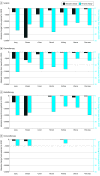Assessment of Changes in Cancer Treatment During the First Year of the COVID-19 Pandemic in the US
- PMID: 37943539
- PMCID: PMC10636648
- DOI: 10.1001/jamaoncol.2023.4513
Assessment of Changes in Cancer Treatment During the First Year of the COVID-19 Pandemic in the US
Abstract
Importance: The COVID-19 pandemic led to disruptions in access to health care, including cancer care. The extent of changes in receipt of cancer treatment is unclear.
Objective: To evaluate changes in the absolute number, proportion, and cancer treatment modalities provided to patients with newly diagnosed cancer during 2020, the first year of the pandemic.
Design, setting, and participants: In this cohort study, adults aged 18 years and older diagnosed with any solid tumor between January 1, 2018, and December 31, 2020, were identified using the National Cancer Database. Data analysis was conducted from September 19, 2022, to July 28, 2023.
Exposure: First year of the COVID-19 pandemic.
Main outcomes and measures: The expected number of procedures for each treatment modality (surgery, radiotherapy, chemotherapy, immunotherapy, and hormonal therapy) in 2020 were calculated using historical data (January 1, 2018, to December 31, 2019) with the vector autoregressive method. The difference between expected and observed numbers was evaluated using a generalized estimating equation under assumptions of the Poisson distribution for count data. Changes in the proportion of different types of cancer treatments initiated in 2020 were evaluated using the additive outlier method.
Results: A total of 3 504 342 patients (1 214 918 in 2018, mean [SD] age, 64.6 [13.6] years; 1 235 584 in 2019, mean [SD] age, 64.8 [13.6] years; and 1 053 840 in 2020, mean [SD] age, 64.9 [13.6] years) were included. Compared with expected treatment from previous years' trends, there were approximately 98 000 fewer curative intent surgical procedures performed, 38 800 fewer chemotherapy regimens, 55 500 fewer radiotherapy regimens, 6800 fewer immunotherapy regimens, and 32 000 fewer hormonal therapies initiated in 2020. For most cancer sites and stages evaluated, there was no statistically significant change in the type of cancer treatment provided during the first year of the pandemic, the exception being a statistically significant decrease in the proportion of patients receiving breast-conserving surgery and radiotherapy with a simultaneous statistically significant increase in the proportion of patients undergoing mastectomy for treatment of stage I breast cancer during the first months of the pandemic.
Conclusions and relevance: In this large national cohort study, a significant deficit was noted in the number of cancer treatments provided in the first year of the COVID-19 pandemic. Data indicated that this deficit in the number of cancer treatments provided was associated with decreases in the number of cancer diagnoses, not changes in treatment strategies.
Conflict of interest statement
Figures
References
Publication types
MeSH terms
LinkOut - more resources
Full Text Sources
Medical


